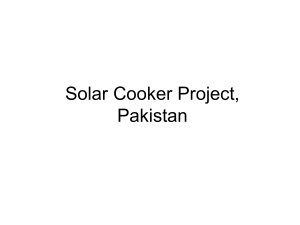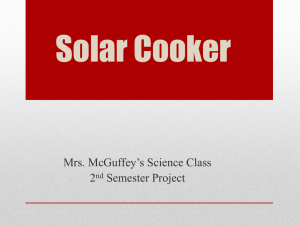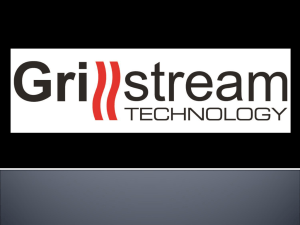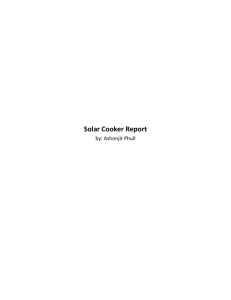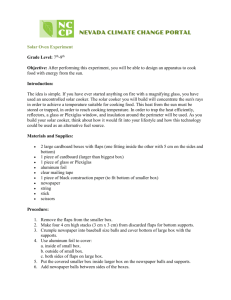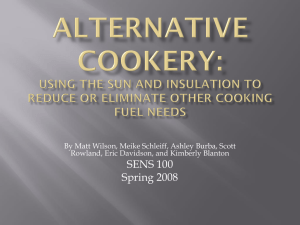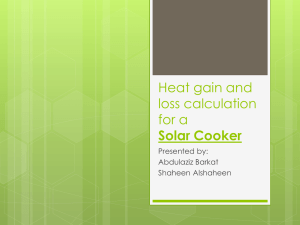Business Plan Project
advertisement
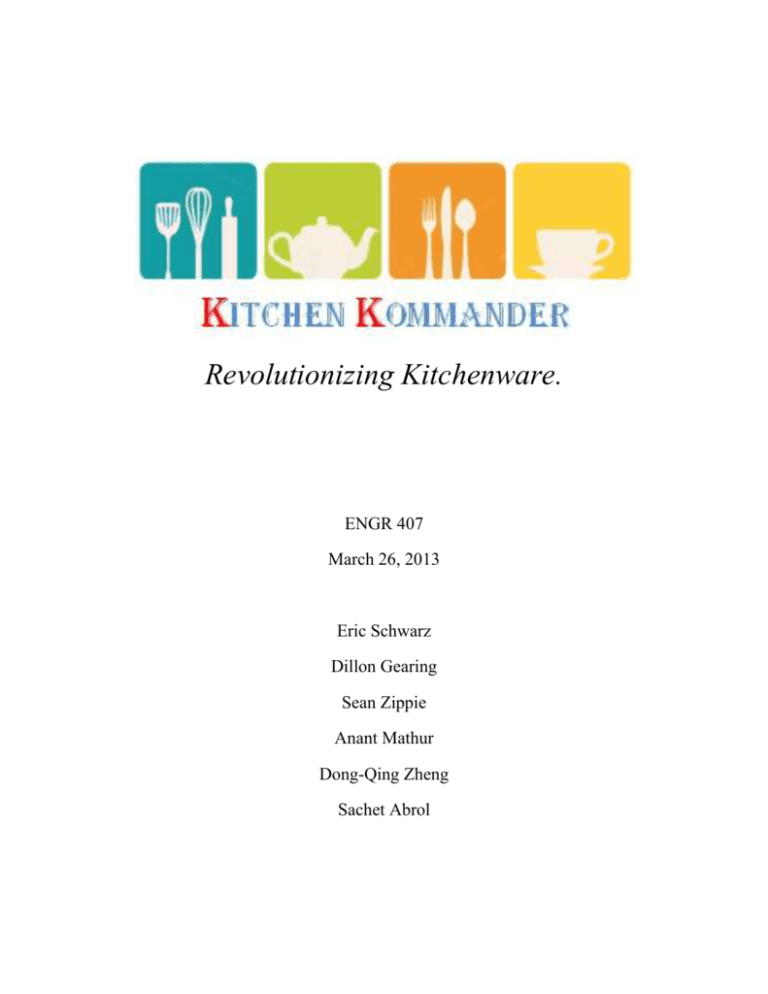
Revolutionizing Kitchenware. ENGR 407 March 26, 2013 Eric Schwarz Dillon Gearing Sean Zippie Anant Mathur Dong-Qing Zheng Sachet Abrol Executive Summary: Cooking healthy food is time consuming. Several slow cooking pots are available in the market with a timer. However, these pots confer to precooking conditions of the food. In most cases, raw foods are supposed to be kept at a refrigerated temperature prior to cooking. We have developed a system that can keep the cooking pot near freezing temperature to make sure the meat and any other ingredients can remain cold. With the help of a multi-step timer, the user will be able to program the pot well in advance, as to when the food would be ready to serve. According to our research, many people shy away from putting meat into a slow cooker if they will be away for a long period of time. Thus, original slow cookers prevent people from making certain meals. We have come up with a comprehensive solution, which allows person to plan a meal in the morning before leaving for work, and be able to cook whatever they would like knowing it will be ready the exact moment they need it. In most of the families, both husband and wife go to work. For these families, dinner planning in the morning and availability of the cooked dinner at a known time will be of great help. There is no such dinner planner in the market and our nearest competitors are timer based cooking pots from Rival, Cuisinart, and others. With our product, our customer will never have to worry about their food spoiling or if it will be fresh. Our product takes care of both of these issues. To begin with, we will not produce any slow cookers in the first year. This will give us time to really focus on our product design that will take most of the year to perfect. In the second year, we plan on selling 6,000 units to major kitchen appliances, such as Williams Sonoma, Sir La Table, cooking.com, and cutleryandmore.com. In our first year, we will lose $307,176 because we have not sold one item yet. In our second year, we plan on selling 6,000 slow cookers to our major retailers and have a net income of $145,224. The third year, our product will be selling in many other retailers and we plan on selling 11,000 units. This year our net income will be $451, 904. This will get us officially out of debt. Competitive Analysis: In today’s society, it is commonplace to find people darting from job to job or class to class in order to meet the increasingly high demands of work. With schedules being stretched so thin, many people coming home for lunch or dinner turn to quickly prepared meals such as TV dinners, fast food, or generally unhealthy food. The issue comes down to the lack of time in people’s schedules to prepare an adequate, satisfying meal. Meal options are greatly narrowed down because of this and “five minute meals” are the result. In the past few years, slow cookers have gained great popularity around the globe. They have given people another method of preparing quality, enjoyable food in a more time efficient manner. Some slow cookers come with timers so the user can spend even less time in the kitchen. Once the food has cooked for the specified amount of time, it will switch to the warm setting. While this does cut down on the time spent in the kitchen, many users complain about the warm setting and how, when kept on for extended periods of time, it leaves the food less 2 fresh. The use of a slow cooker is also not an option for those with little time for meal preparation, since most foods require at least 3 hours to cook in the device. Ideally, busy people would have far more meal options if they were able to decide what food they wanted for lunch or dinner before they left for work, and upon arriving home, the food would be freshly made for them. Based on a survey conducted by our group, about 42% of slow cooker users stray away from cooking food if it must be left at room temperature for extended periods of time. This is why food safety is yet another issue greatly related to meal preparation. The FDA has a detailed list of foods and the temperatures at which they must be stored so they do not spoil. Among these specifications, only a few foods can still be considered safe to eat if kept above 40°F for over 2 hours. These safety regulations greatly restrict meal options and the time people spend preparing them. The Chilly Hot Forget-It Pot would alleviate all the issues related to slow cookers and meal preparation time. Our device is a mini refrigeration unit and a slow cooker in one. The refrigeration system allows users to safely store any food for several hours (if needed). They would use the timer to set a cook time based on how long the food takes to cook and what time they will be arriving for the meal. The unit will still come with a warm setting if the user should not arrive at the time they expected, but in most cases, they will arrive to a freshly prepared meal. In terms of market competition, there is no existing product that combines all the same features into one unit as ours does. Our biggest competition will be with existing slow cooker companies and their potential development of a similar product. Also, a patent of a similar product currently exists, but was only filed in the United States, not internationally. This is described in greater detail in Intellectual Property. Figure 1 below shows a SWOT analysis that the team completed regarding the market potential of The Chilly Hot Forget-It Pot. Internal Strengths Weakness 1) Product is convenient because it allows the user to set the start time of cooking so it will be ready by the time they arrive home 2) Prolonged use of the “warm” setting is no longer necessary since the food will always be fresh 3) Allows busy users more meal options because of the time saved in preparing meals and guaranteed food safety 4) Requires less power than conventional ovens and same amount as regular slow cookers 1) Will cost slightly more than regular slow cookers 2) Only slightly different from already existing products and will be more difficult to advertise as a separate product 3) Shelf space is difficult to obtain with these types of products 3 External Opportunities Threats 1) Could revolutionize way that people cook meals and what types of foods are regularly eaten 2) Several potential retailers would be interested in selling the product 1) Very similar patent for our product already exists, but only in the United States, not internationally Figure 1: SWOT Analysis Intellectual Property: Competing Patents: In regards to competing intellectual property, a patent for a similar product does exist. This patent was filed in 2004, and uses a thermoelectric module (TEM) for heating and cooling the cooking apparatus. This device is similar to ours in several ways. The described system uses a TEM to both heat and cool the device in order to regulate the temperature of the entire apparatus. The device also uses similar parts such as a heat sink and fan in order to help with the temperature regulation. Our Solution: Our team has devised several ways of getting around this roadblock. One way of doing this is by designing around this particular patent. First, our system uses two heat sinks, while the other system only uses one. The bottom of our food storage container will be made of a material that easily absorbs heat, and will draw out heat from the food at a faster rate. The bottom of the storage container directly attaches to the TEM allowing for maximum contact between the two surfaces. The part of the aluminum container that is in contact with the food will have an increased surface area by forming it into several small triangles that transcend the surface. Second, our TEMs are being used purely to cool the apparatus, and not to heat it. A thermal conductive band around the aluminum casing will control the heating function. Third, the fan being used in our system cools the air around it by blowing the air out of the bottom casing allowing cold air to enter the casing through the side vents. Filing patents both in the United States and internationally completes the second solution to this issue. The patent described previously is only filed in the United States, therefore our company has full domain in all other countries around the world. This will allow us to gain an advantage over the competition of our design because we have more of the Intellectual Property space occupied. Doing this will also allow us to expand upon our markets and give us access to more avenues of producing revenue. Finally, if we are unable to obtain a patent in the United States due to this previous patent, we can license the patent from the other inventor. Licensing the patent shown above will give us full 4 access to the markets in the United States, while costing us some of our own revenue. This would be an unfortunate circumstance; however it is a road that our company is willing to walk down in order to further the advancement of our product. Proof of Concept: The Chilly Hot Forget-It prototype is based on the traditional model of crock-pot with the implementing of the thermoelectric module (TEM) cooling system and the programmable timer setting panel. From multiple experiments, we concluded that our working prototype can lower the temperature of 8 lb of water from ~22 ˚C (72 ˚F) to ~4˚C (40 ˚F) within 3 hours, and it can keep 8 lb of water in ~4˚C (40 ˚F). Two 230 watts TEMs are incorporated in the prototype model to pump the heat from the food to the ambient environment in order to keep the food cool and fresh. Since the TEM chip is made with fragile semiconductor Figure 2: Schematic of Installation of the TEMs material and sear stress is detrimental, the two TEMs are compressed and secured between two parallel, polished, and flat aluminum surfaces. Dow Corning Q1-9226 Thermally Conductive Adhesive is used to fill the interface between the TEM and the metal panels to optimize the heat transfer efficiency. On the hot side of the TEM, a fin structure aluminum heat sink is clamed to the metal panel where the configuration is described in Figure 2. On the bottom of the hot side heat sink, a fan is used to facilitate the air circulation, and thus to maximize the heat absorbing efficiency of the fin heat sink. On top of the cold plate, a zigzag structure heat sink is utilized to absorb the heat in the food. The thermo-conductive adhesive is also spread evenly in between the heat sinks and metal panel-contacting surfaces. The programmable time setting panel has the features to control the starting time, the ending time, and the duration of cooling and cooking. Figure 3 is an explore view of the key components of the Chilly Hot Forget-It Pot. Figure 3: Explore View of the Chilly Hot ForgetIt Pot 5 Figure 4: Final Assembly of the Chilly Hot Forget-It Pot Sales and Marketing Plan: Marketing Plan: Our sales and marketing strategy is going to be key for this product. With competitors like Rival, Cuisinart, All-Clad and many more, it is essential for us to differentiate ourselves from the general slow cooker public. This should be somewhat easy for us since we are introducing something that no other slow cooker currently does. The very first marketing project that will be done is creating buzz about our product. We will do this by using social media to our advantage. We will create a very interactive website, where consumers will be able to fully understand how our slow cooker works. Our website will be 100% information based. We will have videos, and information about our slow cooker, but will not have any for sale. The website will solely be for informational purposes because we want our product to only be sold through certain retailers. By only selling it through certain retailers, we will start to create an image of our slow cooker in consumer’s minds that it is a top of the line item that can only be found at certain retailers. Another source of social media we would like to tap into is the Facebook and Twitter world. We will have videos, and creative posts that will show consumers how to use our slow cooker as well as creative recipes that they can use our slow cooker for. When our product is released we will be showcasing it at the International Home + Housewares Show in Chicago, Illinois. By doing this, we can start to network with retailers along with networking with others in the kitchen industry. We will be sending two of our executives to showcase the product in a booth at the showroom. The slow cooker will be on display as well as a time-lapse video that will show them exactly what the slow cooker does. Our goal by going to 6 the home goods show in Chicago, is to prove to retailers that our product will make consumers lives easier and that there is a demand for it. The main companies we will try to attract at this show are the following: Williams Sonoma, Sur La Table, Cooking.com, and Cutleryandmore.com. These companies are some of the biggest kitchenware retail stores across the globe, and we believe by selling to these companies, they give us the best opportunity to reach our target market. These retailers are always looking for creative high end products that are cutting edge, and will create a buzz for consumers in their stores. Through our companies’ market research, we have concluded that our target market for our slow cooker are consumers that spend more than 7 hours away from their home and are working. Our price point for our slow cooker is set to only reach consumers that are serious about their slow cookers. These consumers have a need that our slow cooker fulfills. Throwing food into something that will do the rest for them, and knowing that it will be fresh when they need it, will be a major selling point. Our consumer no longer needs to strategize about their slow cooker meal or when they will run home to turn it on. With our product, the consumer can set it and forget it. This makes our consumer’s life easier. Financials: Year 1 Year 2 Year 3 0 $0 $0 $0 0% 6,000 $828,000 $496,800 $331,200 40% 11,000 $1,518,000 $910,800 $607,200 40% Revenue Units Sold Total Revenue Cost of Goods Sold Gross Profit Gross Profit % Operating Expenses Marketing Trade Show Costs Travel Freight Warehouse 3% Interest on Family Member Loan Total Sales and Marketing Expenses Product Development Product Development Underwriter Laboratories Patent Protection Total Product Development $2,760 $10,000 $2,760 $0 $0 $15,000 $40,520 $5,520 $10,000 $5,520 $5,520 $2,760 $15,000 $54,320 $11,040 $10,000 $11,040 $11,040 $5,520 $15,000 $73,640 $250,000 $5,000 $10,000 $265,000 $125,000 $5,000 $0 $130,000 $75,000 $5,000 $0 $80,000 Operation, Administration & Office Expenses Total Operating Expenses $1,656 $307,176 $1,656 $185,976 $1,656 $155,296 Net Income $-307,176 $145,224 $451,904 7 Financial Summary: The very first step that our group had to take was to see what the price point was for our slow cooker. After researching many slow cookers, we decided that our slow cooker would be best suited as a high end product. With this being said, we have decided that most retailers would sell it at a minimum of $200. Many retailers that sell kitchen appliances operate on a 30% markup. This means that we would sell our product to retailers at $138 per slow cooker. In our first year, we calculated that we would not be selling any slow cookers due to the rigorous task of designing and redesigning our slow cooker, till we have the exact model we would like to sell. Although we will not be selling any products in year 1, we have set money aside for marketing costs. These costs include going to the International Housewares show in Chicago, Illinois and all of the traveling costs that we will incur. One other cost that we have are prepared for, is the interest on the loan that Sean’s uncle has given the company. The rest of year one is filled with product development. We are prepared to pay $250,000 for engineers and designers to work on our slow cooker. We realize, that we are going to have to make many adjustments until we have the exact product we want. The other two costs we have listed are the Underwriters Laboratories expense, and the patent protection for our product. The net income for year 1 is listed at $-307,176. The second year for financials include 6,000 units sold. This is what our company believes we can sell with the help of our four major target retailers. We reached a few sales representatives in the kitchen appliance industry and this was their projection. This gives us a total revenue of $828,000 ($138x6,000 units). Our cost of goods sold is $496,800($82.80x6,000) and is then subtracted from our total revenue, to get a gross profit of $331,200. Our net income for year 2 is $145,224. We are still in debt, but our sales are proving themselves to be in a steady increase in demand. Our operating expenses are similar to year 1 except we have raised the marketing costs, travel costs, warehouse costs, and added in freight costs. In the product development section, we have decided to spend less on product development, since our product is not being sold in stores. The costs now, are going toward new projects. Year 3 is going to be a big year selling our slow cooker. Having a whole year that our product has been on the market will be huge for our sales. Word of mouth marketing is one of the most powerful ways to increase sales. With our marketing continuing to reach consumers and customers telling their friends about our product, we believe that we can increase our units sold by almost double. Now we will start selling to smaller retailers because our product has created a buzz. We will sell 11,000 units in year 3, which will make total revenue $1,518,000. Our cost of goods sold will be $910,000 which makes gross profit $607,000. Many categories in the operating expense section have doubled, due to our product being in year 2 in existence. Marketing costs, travel, warehouse, and freight costs have all doubled since we are nearly doubling our units sold. 8 Product development has substantially decreased because we don’t need as many people working on a new product since we are in year 2, and a new product may be close to being finished. In year 3 our net income is $451,904. This year’s net income allows our company to stand on its own feet now. We are no longer in debt, since our sales nearly doubled this year. We will be sitting on $289,952 and will ready for year 4. 9
